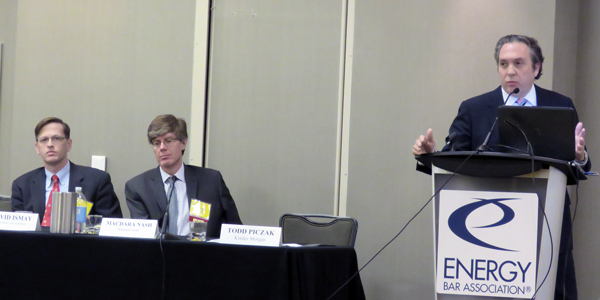By Rory D. Sweeney
WASHINGTON — More than three years and thousands of pages of analysis later, there is no consensus on how the electric industry should respond to the January 2014 cold snap that revealed weaknesses in the Eastern Interconnection.
The differences of opinion were on display during a panel discussion on gas-electric coordination at the Energy Bar Association’s annual conference on Monday.

Nash | © RTO Insider
Macdara Nash of National Grid and Todd Piczak of Kinder Morgan advocated for additional pipelines in the Northeast U.S., saying they would ensure sufficient gas supplies for generators on high-demand days. David Ismay of the Conservation Law Foundation called for peak shaving and increased gas storage, saying additional pipeline capacity would reduce utilization of existing infrastructure most of the time.
One thing all the panelists agreed on is that natural gas has a place in the region’s energy future and that action needs to be taken to better gird the grid against unforeseen events like the polar vortex.
“The region should be thinking about what are solutions, what can we do,” Nash said. “We think that natural gas is key.”
He cautioned that pipelines require an extensive lead time, “so if you believe in the problem [of potential pipeline capacity shortages], the time to act is sooner than later.”
Piczak said FERC has made progress on one half of the problem — ordering increased coordination between gas pipelines and gas-fired generators — but hasn’t done much to facilitate the other half, which is adding capacity. A major issue, he said, is the need for the commission to develop criteria other than long-term contracts to support a finding of public convenience and necessity.

Todd Piczak of Kinder Morgan speaks as fellow EBA Annual Meeting Gas-Electric Coordination Panelists Ismay (left) and Nash listen | © RTO Insider
Piczak’s company operates the Tennessee Gas Pipeline, one of the nation’s most critical natural gas conduits because it runs from Houston to Boston and crosses two prolific shale gas plays, the Utica and Marcellus in the region of Ohio, Pennsylvania and West Virginia.
Not a Capacity Problem
“This is fundamentally a regulatory problem,” he said. “There’s not enough gas for the generators when they need it. … It’s an important problem, and it’s a growing problem.”

Ismay | © RTO Insider
Ismay said the issue isn’t the availability of gas — he said gas was never unavailable, even during the polar vortex — but that constraints and high demand make it prohibitively expensive. A new pipeline would, on average, be about half full half of the year and wouldn’t justify the installation costs, he said.
“Instead of a capacity problem … it’s a temporal, location-based problem of getting a certain amount of gas to a certain location … on the pipeline system at time of year,” he said. “We [will] always have days above the peak, even if we build a new pipeline.”
LNG storage has been and should be the solution, he said, along with demand response and energy efficiency to shave peak demand. He pointed out that while Massachusetts’ electricity rates are the fifth highest in the country, customers’ bills are the 31st lowest on average.
A study of future energy needs in the Bay State, conducted by Analysis Group for the state attorney general, found that, in a business-as-usual scenario, there will be no reliability concerns out to 2030, he said. Moving forward, energy storage, increased pipeline compression, additional pipeline loops and developing targeted markets will address remaining issues.
“If we understand the problem of temporal availability, let’s create a market for it,” Ismay said. “There is a role for natural gas in 2050, but it’s not very big. … It doesn’t run very much in the future.”
With natural gas already occupying 40% of installed generation and providing 50% of the electrons in New England, “our bridge is built” to a low-carbon future, Ismay said.
Discussion attendees pushed back on some of Ismay’s arguments, noting the Massachusetts study assumed best-case, “blue skies” scenarios and that adding localized LNG storage to gas-fired units raises their bid prices to levels comparable with coal-fired units.
“Another important thing to recognize about LNG solutions is you still have to get the gas from the LNG facility to where it’s needed,” Piczak said. “It’s not as easy as just to say, ‘Let’s put some LNG in a tank,’ and it’s going to be available.”
NRDC, J.P. Morgan Skeptical of Pipeline Need
At the EBA’s general session on Tuesday, J.P. Morgan’s Ian C. Connor, and David Doniger of the Natural Resources Defense Council, also expressed skepticism over the need for additional pipelines.
Connor, global co-head of J.P. Morgan’s power & utility group, noted that renewables are supplanting a lot of retired coal capacity.
“I think you’re going to see significantly less gas [generation] build than people believe,” he said. “These [combined cycle gas turbines]: Yes there are a few being built between now and 2020. After 2020, right now no one really thinks any more CCGTs are getting built. So how many more pipelines are you really going to need to build? I think it’s a lot less.”
Doniger, director of NRDC’s Climate & Clean Air program, said the rise of renewables and flat electric demand should prompt FERC to look more skeptically at the need for new pipelines.
“Are we building gas pipelines in order to stimulate the development of new gas power plants or is there really a need?” Doniger asked. “If you look at the system more systematically … efficiency, renewables and some of the other options can [replace] extensions of the gas pipelines and the natural gas infrastructure. The FERC process for evaluating new pipeline applications doesn’t ask all those questions and [it] should.”
Rich Heidorn Jr. contributed to this article.


